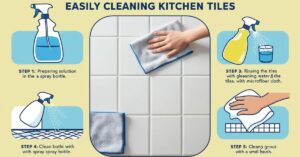Maintaining clean kitchen cabinets is crucial for a spotless and hygienic kitchen. Over time, cabinets can accumulate grease, dust, and food particles, diminishing their appearance and potentially harboring bacteria. Here’s a detailed guide on how to clean kitchen cabinets effectively, ensuring they remain in pristine condition and contribute to an overall cleaner kitchen environment.
Why Cleaning Kitchen Cabinets is Important
Kitchen cabinets are frequently used and exposed to cooking fumes, making them prone to dirt and grime buildup. Regular cleaning not only enhances the aesthetic appeal of your kitchen but also prevents the spread of germs and prolongs the lifespan of your cabinetry.
Tools and Materials You’ll Need
Before you begin, gather the necessary tools and materials:
- Dish soap or mild detergent
- Warm water
- White vinegar
- Baking soda
- Microfiber cloths
- Soft sponge or brush
- Toothbrush (for detailed cleaning)
- Spray bottle
- Protective gloves
Step-by-Step Guide to Cleaning Your Kitchen Cabinets
Step 1: Empty the Cabinets
Remove all items from your kitchen cabinets. This will make it easier to clean every nook and cranny and prevent any items from getting damaged.
Step 2: Dust and Wipe Down Surfaces
Use a dry microfiber cloth to dust off the cabinet surfaces, including the doors, shelves, and handles. This will remove loose dirt and make the subsequent cleaning steps more effective.
Step 3: Prepare a Cleaning Solution
For general cleaning, mix a few drops of dish soap with warm water in a bucket. For tougher grease stains, mix equal parts of white vinegar and warm water in a spray bottle.
Step 4: Clean the Exterior
Dip a soft sponge or cloth into the soapy water solution and wring it out well. Wipe down the exterior surfaces of the cabinets, including the doors and handles. For stubborn spots, sprinkle a small amount of baking soda on the sponge and scrub gently.
Step 5: Clean the Interior
Using the same soapy water solution or vinegar mixture, wipe down the interior surfaces of the cabinets. Pay special attention to corners and edges where grime tends to accumulate.
Step 6: Scrub Detailed Areas
For intricate details and corners, use a toothbrush dipped in the cleaning solution to scrub away any dirt and grime. This is especially useful for ornate cabinet designs or stubborn stains.
Step 7: Rinse and Dry
Wipe down all surfaces with a clean, damp cloth to remove any soap or vinegar residue. Follow up with a dry microfiber cloth to ensure all surfaces are completely dry, preventing any water damage.
Step 8: Replace Cabinet Items
Once the cabinets are thoroughly cleaned and dry, replace all items, organizing them as needed.
Tips for Maintaining Clean Kitchen Cabinets
- Regular Dusting: Dust your cabinets weekly to prevent the buildup of dirt and grime.
- Immediate Cleanup: Wipe down spills and splatters immediately to avoid stubborn stains.
- Use Cabinet Liners: Place liners on shelves to protect the surfaces from spills and stains.
- Professional Cleaning: Consider hiring professional services like CleaningXperts for a thorough and efficient kitchen cleaning. They offer specialized kitchen cleaning services that can help maintain your cabinets in top condition.
Conclusion
Regularly cleaning your kitchen cabinets is essential for a clean and healthy kitchen environment. By following these steps and incorporating regular maintenance into your cleaning routine, you can ensure your kitchen cabinets remain spotless and functional. For a professional touch and thorough cleaning, consider enlisting the help of CleaningXperts, who provide comprehensive kitchen cleaning services tailored to your needs.



